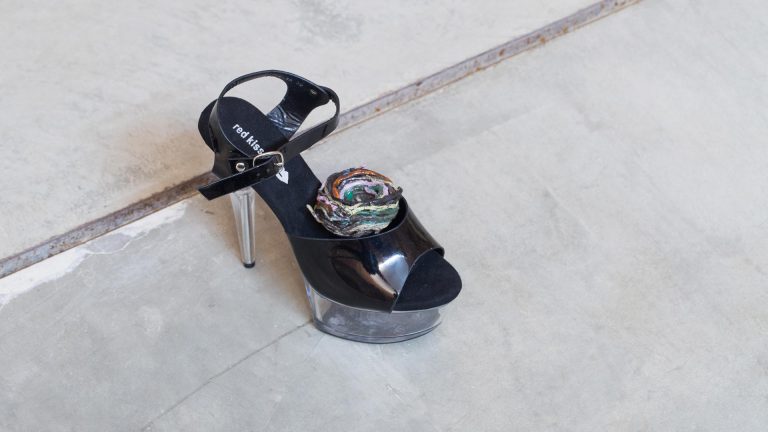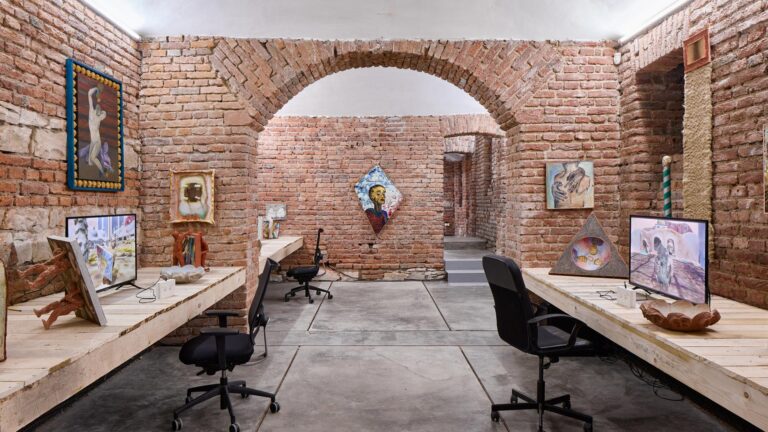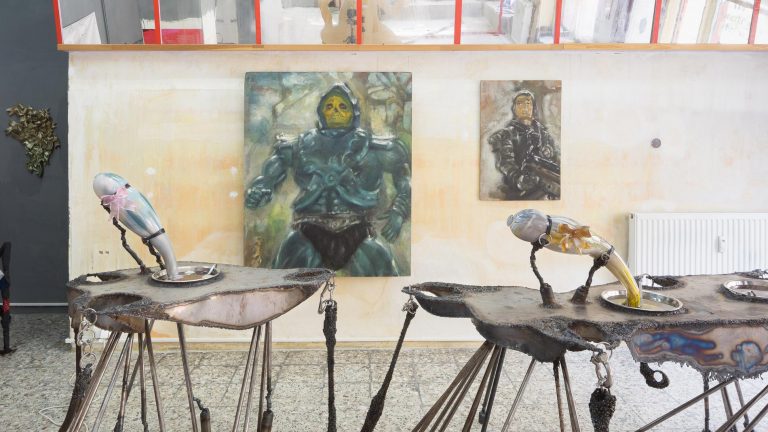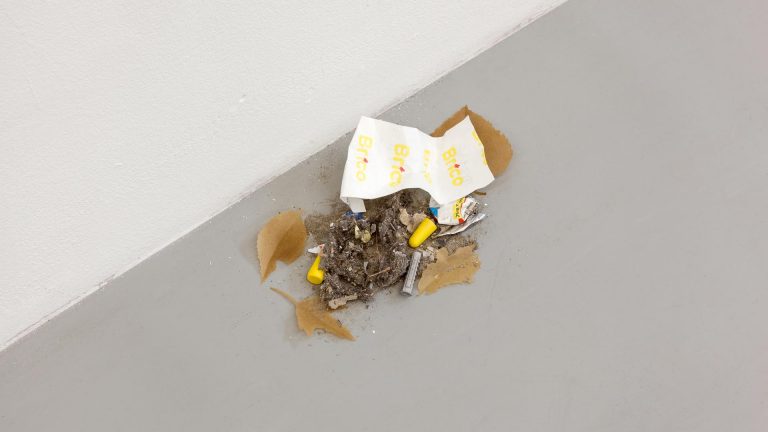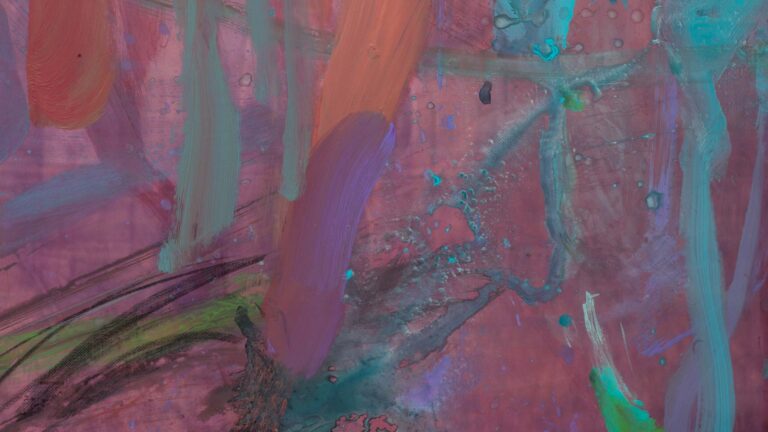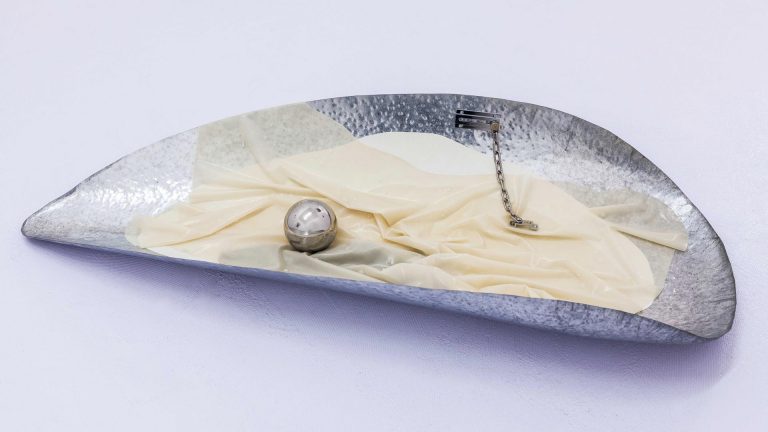Artist: Dominika Dobiášová
Exhibition title: What Hangs in the Palm of Our Hands
Curated by: Eva Slabá
Venue: Hunt Kastner, Prague, The Czech Republic
Date: June 5 – July 27, 2024
Photography: ©Michal Czanderle / all images copyright and courtesy of the artist and Hunt Kastner
Dominika Dobiášová is presenting a series of her most recent, previously unexhibited works at her first ever solo exhibition in Prague. On the surface of five canvases, using a traditional painting installation, she modifies the intimate space of the hunt kastner projekt_room to build a meaningful and rich atmosphere. Thus, just before dawn, we find ourselves with the artist and her figures frozen and suspended in barren landscapes, small clearings, rocky retreats, flooded abysses, or the corridors of a convent. Each individual work in her conception can be seen as a mise-en-scène – a spatial organisation of dramatic action in which the psychological content of the scene and the interaction of the acting characters are revealed using various aspects. Dobiášová’s staging is thoughtfully composed of sub-layers in which nothing is accidental, whether we consider composition, sets, props, characters, costumes or lighting. In addition to this material magic, tone and atmosphere, the arrangement of the scenes and the relationships between them are equally important.
The way of relating to people and their relationship to the world is expressed through narrative, which in the case of this series takes place around the palms of the characters’ hands. The central canvas of the exhibition shows, at first glance, the enigmatic situation of three individuals ignoring each other, seemingly unconnected by anything they share. The interpretive field narrows, however, the moment we begin to observe the interests that emerge precisely through the depicted palms and their own goals. With ‘Hunter, Witch and Picker’, Dobiášová also demonstrates her long-standing interest in uncovering invisible power games and how these mechanisms affect not only historical interpretation (we can mention Ursula Le Guin’s thinking about fiction and narrative or Silvia Federici’s critical alternative). The remaining canvases, thanks to their titles, suggest a clearer reading, but they are nevertheless still conjectures and guesses. Indeed, the artist deliberately distorts the almost romantic scenes before dusk by depicting heavy and distressing (at times archetypal) themes in the form of the isolation of the characters, the weaving of a web of intrigue, individual revenge, warming one’s own bath, false help or empathetic weeping for someone else’s pain and self-sacrifice. It is this sensitively set tension that Dobiášová uses to explore the boundaries between danger and serenity, but also, perhaps, beauty and ugliness. Moreover, the “non-subjects” in this series are not only things, but also phantoms, flora and fauna, and she gives them all equal attention.
Although one can suspect the background of the ongoing conflict behind the depicted plots, the painter’s portrayal is more of an overall representation of an ongoing construction that is not techno-heroically linear, but rather anachronistic and non-sequential. The visual metaphors she thus composes are ambiguous and heterogeneous, part of a category of “long shots” that unfold over time and in different directions, standing in opposition to the one-dimensional actions. The characters she depicts are no longer even in competition with each other – each is fighting their own battle with or for themselves. This ultimately allows her to critically reflect on political and social phenomena, through which she achieves symbolic and at times allegorical scenes thematizing collective guilt and shared responsibility in a coexisting hierarchy of social systems. Together with the author, we thus look back at historical ethical dilemmas and ask what is still within our own power and what are the forms of contemporary collective efforts – what hangs in the palm of our hands?
Dominika Dobiášová (*1996, Ostrava) completed her bachelor’s degree at the Faculty of Arts of the University of Ostrava in the drawing studio of Josef Daňek and Libor Novotný, and her master’s degree at the Brno University Faculty of Fine Arts in the painting studio of Vasil Artamonov and Maria Štindlová. During the academic year 2022/2023 she participated in an internship in Vienna in the studio of Ernst Yohji Jaeger. While Dobiašová’s paintings are characterized by associations to various styles from art history, such as Renaissance, Gothic, and Surrealism, these forms are disrupted by an authentic contemporary handwriting that builds tension between the subject matter and the technique used. The canvases are often complemented by the artist’s original wooden frames and the installations are occasionally accompanied by objects made of blown glass.
In June of this year, Dobiášová has a residency at the A.R.C. in Bucharest and a group exhibition at 8smička, and in the autumn she will participate in group exhibitions at Pragovka and the Zlín Youth Salon. A solo exhibition is being prepared for winter 2025 by the Viennese gallery Commune. Recent solo exhibitions include Reap The Sown (eastcontemporary, Milan, IT, 2023), Bring Me a Flower, I Will Reward You (Zaazrak Dornych, Brno 2022) or Sanctuary for Each of Them (TIC Gallery, Brno, 2022). She has also participated in a number of group exhibitions, including Chaotic Maze (AM180, Prague, 2024), Cheirokmeta (Sperling, Munich, DE, 2023), Kingdom of Hex (MeetFactory, Prague, 2023), I Can Hear the Grass Grow (PLATO, Ostrava, 2022) and Personal Mythologies (House of the Lords of Kunštát, Brno, 2022). Dobiášová lives and work in Brno, Czech Republic.















